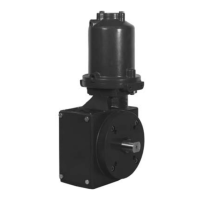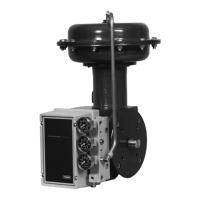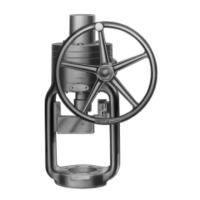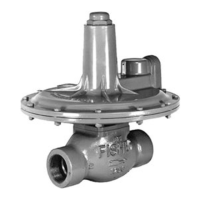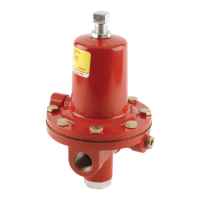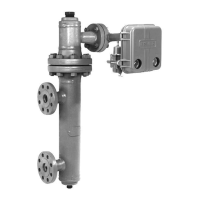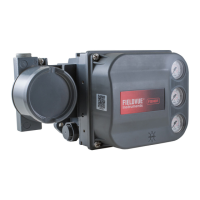Types 1098-EGR and 1098H-EGR
19
7. Upon reassembly, pay particular attention to the
following assembly suggestions.
a. Before replacing the diaphragm case or spring
case, be sure the yoke assembly is positioned
so that it will not bind or rub on the prong in the
relay body.
b. Avoid wrinkling the diaphragms when replacing
the diaphragm case and spring case.
c. Replace the diaphragm case, carefully working
the upper relay diaphragm (key 14) into the
recess in the diaphragm case. If the diaphragm
case rocks with respect to the pilot body, the
diaphragm is probably wrinkled.
d. Replace the spring case, using care to smooth
the lower relay diaphragm (key 15) evenly into
the recess in the pilot body.
e. Install the eight cap screws, tightening them
down evenly in a crisscross pattern to avoid
crushing the diaphragm. Recommended nal
torque on these cap screws in 10 to
12 foot-pounds (14 to 16 N•m).
8. After assembly, make sure of the proper control
spring setting according to the Installation and
Startup section, and restamp the nameplate
(key 27) if necessary.
9. To gain access to the Type 1806 relief valve,
disconnect the relief tubing at the connector
tting and unscrew the relief valve. Make sure
the spring closes the ball, or replace the relief
valve if necessary. Install the relief valve back
in the pipe tee (key 16) and reconnect the relief
tubing (key 18) and connector tting.
Type Y600AM Pilot
Body Area
This procedure is for gaining access to the disk
assembly, orice, body O-ring, and pitot tube if used.
All pressure must be released from the diaphragm
casing, and the disk assembly must be open, before
these steps can be performed.
1. Remove the cap screws (key 2) and separate the
diaphragm casing (key 4) from the body (key 1).
2. Remove and inspect the body seal O-ring (key 11)
and the backup ring (key 48). See Figure 22.
3. Inspect and replace the orice (key 5) if
necessary. Protect the orice seating surface
during disassembly and assembly. Lubricate the
threads of the replacement orice with a good
grade of light grease and install with 29 to
37 foot-pounds (39 to 50 N•m) of torque.
4. To replace the disk assembly (key 13), remove the
cotter pin (key 15). If not necessary, skip to step 7.
5. To replace the pitot tube (key 32, Figures 21)
on the Type Y600A, remove the machine
screws (key 33), install the new pitot tube, and
secure with the machine screws. Position the
pitot tube so that it points into the outlet of the
body (key 1) by rotating the guide insert (key 18).
6. Install the disk assembly (key 13) and secure it
with the cotter pin (key 15).
7. Place backup ring (key 48) into the body (key 1).
Then place the body seal O-ring (key 11) into the
body. See Figure 21.
8. Place the diaphragm casing (key 4) on the body
(key 1). Secure the the diaphragm casing to the
body with the cap screws (key 2) using 7 to
9 foot-pounds (9 to 12 N•m).
Diaphragm and Spring Case Area
This procedure is for gaining access to the spring,
diaphragm, lever assembly stem, and Type Y600AM
stem O-ring. All pressure must be released from the
diaphragm casing before performing these steps.
1. Remove the closing cap (key 22), and turn the
adjusting screw (key 35) counterclockwise to
remove the compression from the spring (key 6).
2. If the only maintenance is to change the control
spring, take out the control spring and replace
with the desired spring. Turn the adjusting screw
(key 35) clockwise to compress the spring to the
desired outlet pressure setting. Skip to step 11.
3. If further maintenance to the internal diaphragm
casing parts is required, remove the hex nuts
(key 23, not shown) and cap screws (key 24).
Remove the diaphragm (key 10) plus attached
parts by tilting them so that the pusher post (key 8)
slips off the lever assembly (key 16). To separate
the diaphragm from the attached parts, unscrew
the cap screw (key 38, Figures 21 and 22) from
the pusher post (key 8). If the only maintenance
needed is to replace the diaphragm parts, skip
to step 7.
4. To replace the lever assembly (key 16), remove
the machine screws (key 17). To replace the
stem (key 14) or stem O-ring (key 30, Figures 21
and 22), also perform Body Area Maintenance
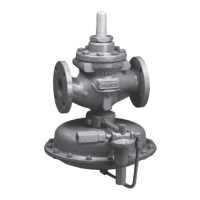
